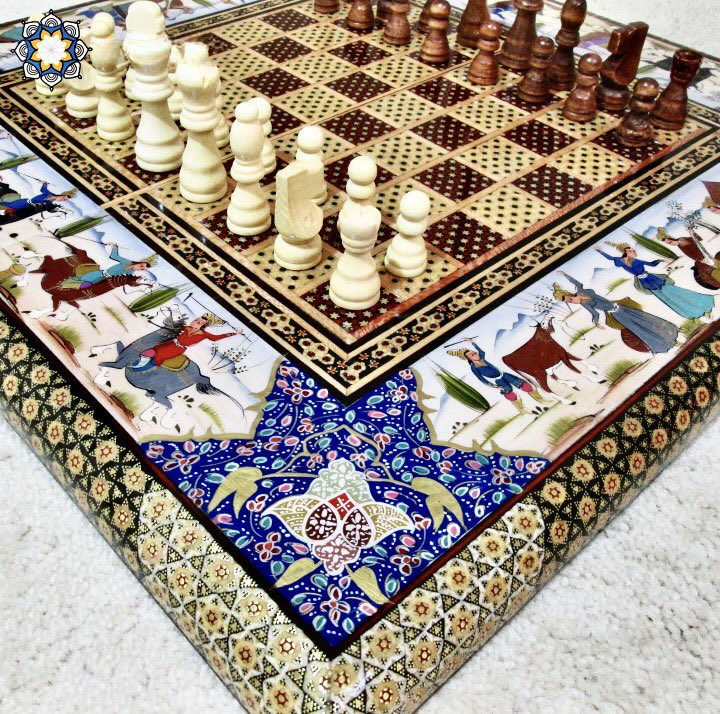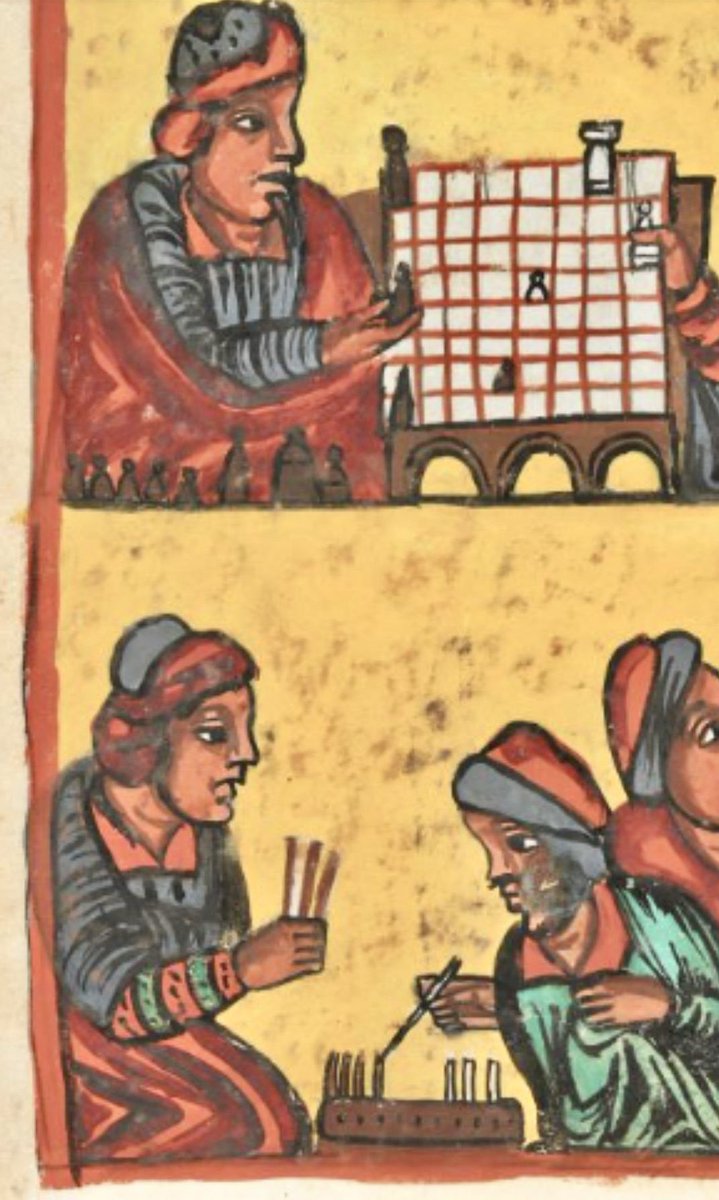Chess is a significant part of Muslim history. The game originated in northern India in the 6th century AD & spread to Persia. When the Arabs conquered Persia, chess was taken up by the Muslim world
For #WorldChessDay here is the history of chess & Muslim heritage
A thread...
For #WorldChessDay here is the history of chess & Muslim heritage
A thread...

1/ The Indian ancestor of Chess was called chaturanga, developed in the 6th century AD meaning “4 Members”, it comes from the 4 military divisions of the Indian army: infantry, cavalry, elephantry, & chariotry.
Two women play Chaturanga, c. 1805 — c. 1815
#WorldChessDay
Two women play Chaturanga, c. 1805 — c. 1815
#WorldChessDay

2/ Eventually, the game spread to Persia. After the Islamic Conquest of Persia, the game spread westward & a large portion of the Arabian population began to take up chess where it became known as Shatranj
Chess Piece as Seated Man, 13th c. Iran @KhaliliOnline
#WorldChessDay
Chess Piece as Seated Man, 13th c. Iran @KhaliliOnline
#WorldChessDay

@KhaliliOnline 3/ The conquest of Persia by Islam is known to be the most important development in the history of the game of chess. Historians have accounted for the Muslim world’s relationship with the game of chess as they took chess with them wherever they conquered #WorldChessDay 

@KhaliliOnline 4/ Chess Set, 12th century, Iran
@metmuseum
This nearly complete chess set is one of the earliest extant examples in the world. The pieces are abstract forms: the shah (king) is represented as a throne; the vizier (the equivalent of the queen) is a smaller throne #WorldChessDay
@metmuseum
This nearly complete chess set is one of the earliest extant examples in the world. The pieces are abstract forms: the shah (king) is represented as a throne; the vizier (the equivalent of the queen) is a smaller throne #WorldChessDay

@KhaliliOnline @metmuseum 5/ In Arab countries the caliphs popularised chess among Muslim circles. Caliph Harun al-Rashid made chess into a mandatory court activity. He sought out skilled chess players with unusual prowess, for example, the ability to play chess blindfolded #WorldChessDay 

@KhaliliOnline @metmuseum 6/ Harun al-Rashid would admit these players, despite their economic standing, and present them with riches. This move was translated in the chess move of “queening”: promoting a pawn to the rank of vizier
Saladin al-Ayoubi and Caliph Harun al-Rashid #WorldChessDay
Saladin al-Ayoubi and Caliph Harun al-Rashid #WorldChessDay

@KhaliliOnline @metmuseum 7/ The Charlemagne chess set might just be the most famous chess set in the world. Legend has it that an exquisite set of chessmen was presented to King Charlemagne as a gift from Caliph Harun al-Rashid.
A replica of the Charlemagne chess #WorldChessDay
A replica of the Charlemagne chess #WorldChessDay

@KhaliliOnline @metmuseum 8/ Harun’s successor his son al-Amin (died 813) has an incredible chess tale: At a critical point in the siege of Baghdad by forces loyal to his half-brother al-Ma‘mun, he received a message while playing chess that Baghdad’s capture was imminent
Painting of Seige #WorldChessDay
Painting of Seige #WorldChessDay

@KhaliliOnline @metmuseum 9/ The 2 most famous Abbasid chess masters, al-Lajlaj and al-Suli, appeared in the 10th century. Both are known from extracts of their writings in 2 manuscripts of the Book of Chess: Extracts From the Works of al-Adli, as-Suli & Others, compiled in the 12th century #WorldChessDay 

@KhaliliOnline @metmuseum 10/ At the Baghdad court, chess was not a silent affair. Players were expected to maintain a witty banter with each other & with spectators. “Chess players employ different kinds of pleasantry & jests designed to astound” wrote the 14th-century historian al-Mas‘udi #WorldChessDay 

@KhaliliOnline @metmuseum 11/ Buzurgmihr Masters the Game of Chess from the Shahnama Book of Kings ca. 1300–30
How chess was introduced in Iran from India - apparently to avoid paying tribute to the Sasanians the Rajah of India sent an envoy challenging the Iranian ruler to figure out chess #WorldChessDay
How chess was introduced in Iran from India - apparently to avoid paying tribute to the Sasanians the Rajah of India sent an envoy challenging the Iranian ruler to figure out chess #WorldChessDay

@KhaliliOnline @metmuseum 12/ After the Arabs conquered the Iberian Peninsula, known today as the countries of Portugal and Spain, the game was introduced into this part of Europe. The Caliphate of Cordoba promoted the culture, education, and sciences–which included chess #WorldChessDay 

@KhaliliOnline @metmuseum 13/ A Jew and a Muslim playing chess in al-Andalus.
El Libro de los Juegos, 13th century
Historically playing chess has connected cultures and people, as it is based on intellectual challenges and logical skills.
#WorldChessDay
El Libro de los Juegos, 13th century
Historically playing chess has connected cultures and people, as it is based on intellectual challenges and logical skills.
#WorldChessDay

@KhaliliOnline @metmuseum 14/ Alfonso X (1221¬–1284), king of Castile, Léon & Galicia, was a Christian patron of translations of Arabic learning.
His Book of Games suggests that chess in 13th century Spain was in transition from the game played in the Middle East & North Africa #WorldChessDay
His Book of Games suggests that chess in 13th century Spain was in transition from the game played in the Middle East & North Africa #WorldChessDay

@KhaliliOnline @metmuseum 15/ The game grew to become an essential act of pastime for travelers, helping in the further spread throughout Europe. The first account of the game of chess in Western Europe dates back 1010 A.D.
A Christian and a Muslim playing chess, late 1200s.
#WorldChessDay
A Christian and a Muslim playing chess, late 1200s.
#WorldChessDay

@KhaliliOnline @metmuseum 16/ In the 10th & 11th centuries, chess spread to Russia & Scandinavia from the Middle East with the Norse Volga River trade. Slightly later, chess moved into Italy.
A chess piece, Fatimid dynasty period, Egypt, 10-11th century, found in Sicily @britishmuseum #WorldChessDay
A chess piece, Fatimid dynasty period, Egypt, 10-11th century, found in Sicily @britishmuseum #WorldChessDay

@KhaliliOnline @metmuseum @britishmuseum 17/ This is a manuscript on chess strategy from 1257CE (655AH), previously owned by the Ottoman Sultan, Bayezid II #WorldChessDay








@KhaliliOnline @metmuseum @britishmuseum 18/ Vizier Buzurghmihr Showing the Game of Chess to King Khusraw Anushirwan, Turkey, 1525-1575
The central scene here depicts Buzurghmihr showing chess to his shah in a leisurely gathering. Though referencing a tale set in Iran, the scene evokes an Ottoman palace #WorldChessDay
The central scene here depicts Buzurghmihr showing chess to his shah in a leisurely gathering. Though referencing a tale set in Iran, the scene evokes an Ottoman palace #WorldChessDay

@KhaliliOnline @metmuseum @britishmuseum 19/ The oldest chess set ever found dates circa 700, made of ivory, from Afrasiab, near Samarkand (Uzbekistan) - a historically important city of Central Asia on the Silk Route, the old trade route between China & the Mediterranean
#WorldChessDay https://t.co/hUI15PnzlGhistory.chess.free.fr/afrasiab.htm

#WorldChessDay https://t.co/hUI15PnzlGhistory.chess.free.fr/afrasiab.htm

@KhaliliOnline @metmuseum @britishmuseum 20/ The Persian term shah for the king chess piece drifted into various languages as the name of the game: scacchi in Italian, schaakspiel in Dutch, Schachspiel in German, shkak in Serbian, skaktafl in Icelandic & éches in French, from which comes chess in English #WorldChessDay 

@KhaliliOnline @metmuseum @britishmuseum 21/ Across localities the shapes of the pieces varied. In Central Asia, for example, the camel sometimes replaced the elephant. Among Tibetans, the lion replaced the king & the tiger replaced the vizier
Mughal Chess Set, the pieces are Indian riders on animals #WorldChessDay
Mughal Chess Set, the pieces are Indian riders on animals #WorldChessDay

@KhaliliOnline @metmuseum @britishmuseum 22/ Sänṭäräž ሰንጠረዥ is a regional chess variant played in Ethiopia and Eritrea. Traditionally, the board is not checkered, but marked into squares
18th c. MS painting of Senterej, Mancala & the ancient Egyptian #boardgame Hounds & Jackals credit @DerilloEyob
18th c. MS painting of Senterej, Mancala & the ancient Egyptian #boardgame Hounds & Jackals credit @DerilloEyob

@KhaliliOnline @metmuseum @britishmuseum @DerilloEyob 23/ Chess was popular in Mughal India, a favoured game by Mughal Emperors. This South Indian chess set, 1775-1825 represents the opposing teams through opulent gem set pieces with rubies and emeralds. Sold at Christies for $187,500 #WorldChessDay 

@KhaliliOnline @metmuseum @britishmuseum @DerilloEyob 24/ An article from "Frank Leslie's Popular Monthly" (1883) called "Living Chess" claims that the Mughal, India emperor, Akbar (1542-1605) supposedly played a game of living chess on the pavement of the Pachisi court at Fatehpur Sikri #WorldChessDay 

@KhaliliOnline @metmuseum @britishmuseum @DerilloEyob 25/ Today, chess is played all around the globe. We cannot speak of the historical growth of the game of chess without accounting for the role that the Muslim world played in the game that many, know & love today
Find out more about Muslim heritage & chess:… twitter.com/i/web/status/1…
Find out more about Muslim heritage & chess:… twitter.com/i/web/status/1…
@KhaliliOnline @metmuseum @britishmuseum @DerilloEyob Want to discover incredible craft traditions across the Muslim World?
Join us as we bring together a panel of talented artisans and makers who specialise in traditional craft practices, redefining them in a contemporary context. Prepare to be captivated by the intricate… https://t.co/DCHbldHMnXtwitter.com/i/web/status/1…

Join us as we bring together a panel of talented artisans and makers who specialise in traditional craft practices, redefining them in a contemporary context. Prepare to be captivated by the intricate… https://t.co/DCHbldHMnXtwitter.com/i/web/status/1…

• • •
Missing some Tweet in this thread? You can try to
force a refresh






















